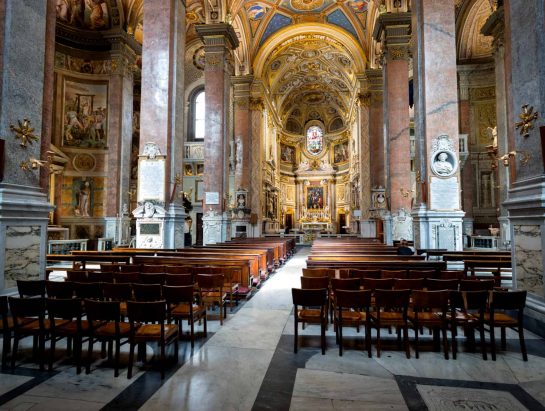Kirche Santa Maria dell’Anima
Die heutige Kirche ist die dritte an gleicher Stelle und befindet sich in unmittelbarer Nachbarschaft zur Kirche Santa Maria della Pace. Das besondere Merkmal des Außenbaus ist der schlanke, fast zierliche Campanile, der oberhalb des Kirchengebäudes zweieinhalbgeschossig in die Höhe ragt. In Zusammenhang mit dem Namen „Santa Maria dell’Anima” ist vor allem die Giebelplastik über dem Hauptportal der Kirche erwähnenswert: die thronende Himmelskönigin mit dem Jesuskind wird von zwei nackten Gestalten – „animae” – arme(?) Seelen – flehentlich angerufen, die zu ihrer Seite knien.
Der Innenraum der Kirche ist als eine dreischiffige, vierjochige Halle mit quergerichteten Kapellen in Form von Nischen angelegt. Der Kapellen gibt es acht: St.-Benno-Kapelle; St.-Anna-Kapelle; St.-Markus- oder Fugger-Kapelle; Pietà-Kapelle; Markgrafen-, Kreuz- oder Zenturio-Kapelle; St.-Barbara-Kapelle; St.-Johannes-Nepomuk-Kapelle; St.- Lambertus-Kapelle. Bedingt durch die Grundstücksverhältnisse ist das Langhaus trapezförmig verzogen; der Raum wird von im Grundriss kreuzförmigen Pfeilern gegliedert. Ein besonderes Symbol, welches auch im Innenraum der Kirche zu finden ist, ist der doppelköpfige Reichsadler. Er bringt den geglückten Versuch zum Ausdruck, die „Anima” unter den Schutz des römischen Reiches deutscher Nation zu stellen. Im 18. Jahrhundert ging das kaiserliche Protektorat dann auf das Haus Habsburg persönlich über.
Zu den herausragenden Kunstschätzen der Kirche Santa Maria dell’Anima zählen das Altarbild von Giulio Romano, das Grabdenkmal Papst Hadrians VI., sowie die Werke von Francesco Salviati, Carlo Saraceni, Lorenzetto (mit richtigem Namen Lorenzo Giovanni di Ludovico) und Girolamo Siciolante (genannt „il Sermoneta”).
